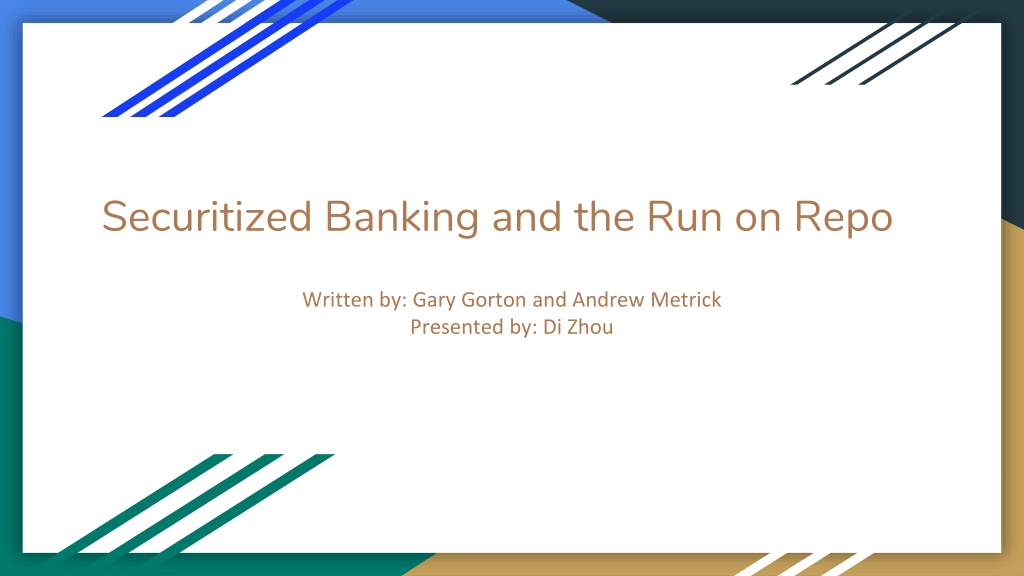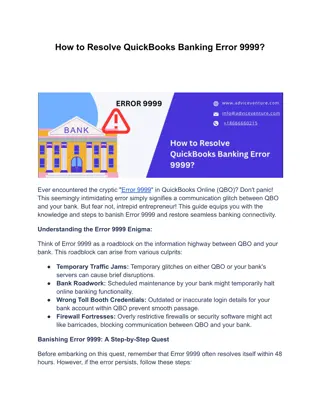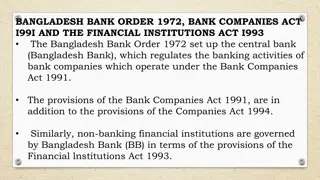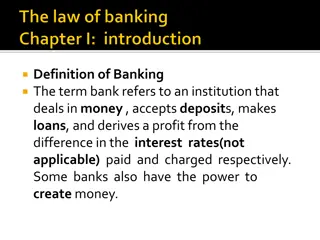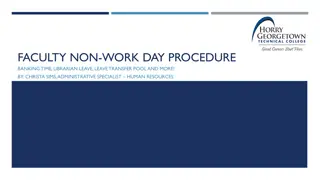Securitized Banking and the Run on Repo
The financial system has evolved with securitized banking and the use of repo markets for liquidity provision. Learn about securitization, repo agreements, and types of securitization instruments like CDOs and ABS.
Download Presentation

Please find below an Image/Link to download the presentation.
The content on the website is provided AS IS for your information and personal use only. It may not be sold, licensed, or shared on other websites without obtaining consent from the author.If you encounter any issues during the download, it is possible that the publisher has removed the file from their server.
You are allowed to download the files provided on this website for personal or commercial use, subject to the condition that they are used lawfully. All files are the property of their respective owners.
The content on the website is provided AS IS for your information and personal use only. It may not be sold, licensed, or shared on other websites without obtaining consent from the author.
E N D
Presentation Transcript
Securitized Banking and the Run on Repo Written by: Gary Gorton and Andrew Metrick Presented by: Di Zhou
Background The financial system has changed dramatically since the establishment of banking insurance in the US about 75 years ago. The establishment of the FDIC largely ended commercial bank runs. However, the vast majority of liquidity provision/maturity transformation now is done using other financial instrument, not protected by deposit insurance. This paper explores the idea that a major form of liquidity provision is done through repo markets. Like demand deposits at commerical banks, repo loans are runable
What is securitized banking? Step1: the investor receives collateral from the bank. In practice, this deposit-collateral transaction takes the form of a repo agreement Step2: outsources the loan underwriting function to direct lender Step3: direct lender underwrites loans to borrowers Step4: the intermediation activities that transfer most of the mortgage loans to outside investors in Step 4.used as collateral
What is Repo? A repurchase agreement( or repo) is a financial contract used by market participants as a financing method to meet short-term liquidity needs. It is a two-part transaction. The first part is the transfer of specified securities by one party, the bank or borrower, to another party, the depositor or lender, in exchange for cash the depositor holds the bond, and the bank holds the cash. The second part of the transaction consists of a contemporaneous agreement by the bank to repurchase the securities at the original price, plus an agreed upon additional amount on a specified future date.
Securitization An important part of the subprime mortgage innovation was how the mortgages were financed. In 2005 and 2006, about 80% of the subprime mortgages were financed via securitization, that is, a mortgage was sold in as part of a residential mortgage-backed security (RMBS), which involves pooling thousands of mortgages together, selling the pool to a special purpose vehicle (SPV) which finances their purchase by issuing investment-grade securities (i.e., bonds with ratings in the categories of AAA, AA, A, and BBB) with different seniority (called tranches) in the capital markets. Securitization does not involve public issuance of equity in the SPV. SPVs are bankruptcy remote in the sense that the originator of the underlying loans cannot claw back those assets if the originator goes bankrupt. Also, the SPV is designed so that it cannot go bankrupt.
Types of Securitization Collateralized Debt Obligations (CDO) Asset Back Securities (ABS) Commercial Mortgage Backed Securities (CMBS) Residential Mortgage Backed Securities (RMBS)
Purpose of this paper Theory: Can securitized bank runs exist? Empirical: Are increasing haircuts, as measured here, a good proxy for a run? Magnitudes: Was a repo-run the cause of the financial crisis? We refer to the combination of securitization plus repo finance as securitized banking and argue that these activities were at the nexus of the crisis. We use a novel data set that includes credit spreads for hundreds of securitized bonds to trace the path of the crisis from subprime-housing related assets into markets that had no connection to housing. We find that changes in the LIB-OIS spread, a proxy for counterparty risk, were strongly correlated with changes in credit spreads and repo rates for securitized bonds. These changes implied higher uncertainty about bank solvency and lower values for repo collateral.
what is a bank run? Diamond & Dybvig (1983) develop a model of (commercial) bank runs. There are two principal players in their model: The borrowers (businesses) want to make long-term illiquid investments. If they hold the loan to maturity, the return is high. If they are forced to liquidate the investments early, the payoff will be low. The lenders (depositors) have capital to invest, but are sometimes faced with liquidity shocks.
Bank Runs Depositor s liquidity are shocks idiosyncratic so, because of diversification, banks generally can meet all withdrawls. However, if the withdrawls are large, even a healthy bank can fail. in this case, it cannot pay its depositors in full. Knowing this, investors rush for the exits if they think that others are withdrawing capital. You need to get your capital out before the bank runs out of reserves. After that, if the bank liquidates assets, it still won t be enough to pay off all depositors
Repo-Market Runs Since securitized lending is collateralized, one would think that runs couldn t occur. If the borrower were to default, the lender would receive the collateral (i.e.,, ABS), which could then be sold on the open market. The problem arises if the market for the collateral disappears. This could happen if everyone who had information about the collateral had no capital. This is implausible for repos of treasuries/agency securities, but probably not for specialized ABS s.
Haircuts Lenders only receive collateral in the case of failures. the lender has a put option. Thus, to break even, the lender will only be willing to lend the risk adjusted expected value of the collateral, conditional on a failure to deliver. An implication is that we should expect to see large haircuts, but only while there is a lemons problem. Once assets are being sold at fire sale prices, haircuts will fall to zero. The price is equal to the value of the collateral, conditional on the borrowers failure as a group.
State Variables ABX: Proxies for fundamentals of the subprime market equal weighted subprime RMBS tranches. Thus, for our purposes the ABX indices are important because of the information revelation about the value of subprime mortgages, which in turn depends on house prices. . Credit derivative that references 20 BBB ABX tranche of the first vintage of the ABX in 2006 : riskier levels of subprime securitization OIS: a measure of interest rate expectations over the same term LIB-OIS Spread: the state of the interbank market and, in particular, the repo market. It is the spread between three-month LIBOR and the overnight index swap rate Can be though of as a proxy for countrparty risk in repo transactions Used for fears about bank insolvency Used for the state of the interbank market(repo market)
Summary The first systematic event occurs in August 2017, with a shock to the repo market that we demonstrate using the LIB-OIS. The market slowly became aware of the risks associated with the subprime market, then it led to doubts about repo collateral and bank solvency. After August 2007, the securitized-banking model was under pressure, with small equity bases stretched by increasing haircuts on high-grade collateral. We see evidence of this pressure in the co-movement of spreads on a wide variety of AAA and AA credits. This pressure contributed to the forced rescue of Bear Stearns in March 2008 and the failure of Lehman Brothers in September 2008. The second systemic event and run on repo occurred with the failure of Lehman.
Basel III Pillar I: Enhanced Minimum Capital and Liquidity Requirements Pillar II: Enhanced Supervisory Review Process for Firm-wide Risk Management and Capital Planning Pillar III: Enhanced Risk Disclosure & Market Discipline
